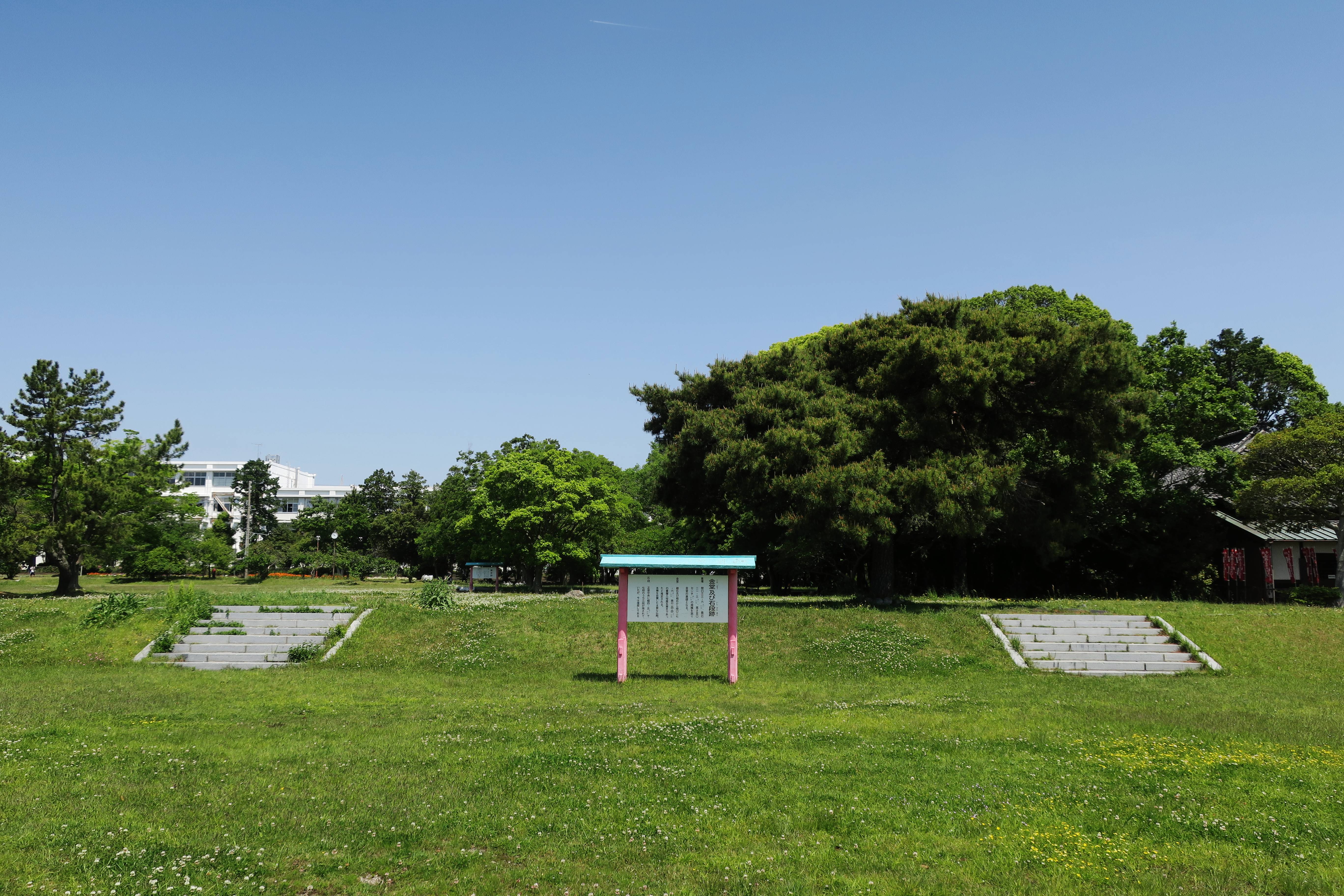|
Ryōsen-ji
is a Nichiren-sect Buddhist temple in the city of Shimoda, Japan. It is noteworthy as the location of the signing ceremony for the Treaty of Amity and Commerce (also known as the ''Harris Treaty'') between the Tokugawa shogunate of Japan and the United States of America on July 29, 1858. Due to this connection, the temple grounds and main hall have been designated as a National Historic Site. History Ryōsen-ji was founded in 1635 by the prelate Nitchō, with the support and patronage of 2nd Shimoda bugyō Imamura Masanaga and was later rebuilt in 1826. The Hondō was again reconstructed in 1945. Three large ''Gorintō'' stone monuments on the grounds (the graves of a number of the Shimoda ''bugyō'') are designated as Shimoda City historic monuments. During the visit of Commodore Matthew Calbraith Perry to Shimoda in 1854 in one of the initial attempts by the United States to end the national isolation policy of the Japanese government, the temple was designated as his sho ... [...More Info...] [...Related Items...] OR: [Wikipedia] [Google] [Baidu] |
Shimoda, Shizuoka
270px, Shimoda City Hall is a city and port located in Shizuoka Prefecture, Japan. , the city had an estimated population of 21,402 in 10,787 households, and a population density of 200 persons per km2. The total area of the city is . In the 1850s, Japan was in political crisis over its increasing inability to maintain its national seclusion policy and the issue of what relations, if any, it should have with foreign powers. For a few years, Shimoda was central to this debate. Geography Shimoda is located at the southern tip of the Izu Peninsula about 100 kilometres southwest of Tokyo. Shimoda's location, with the Amagi Mountains to the north, and the warm Kuroshio Current to the south give the city a humid, sub-tropical climate. Surrounding Municipalities *Shizuoka Prefecture **Minamiizu ** Kawazu ** Matsuzaki Demographics Per Japanese census data, the population of Shimoda has been in slow decline over the past 40 years. Climate The city has a climate characterized by ... [...More Info...] [...Related Items...] OR: [Wikipedia] [Google] [Baidu] |
List Of Historic Sites Of Japan (Shizuoka)
This list is of the Historic Sites of Japan located within the Prefecture of Shizuoka. National Historic Sites As of 1 January 2021, forty-eight Sites have been designated as being of national significance (including three *Special Historic Sites); the Joseon Mission Sites span the borders with Hiroshima and Okayama, Old Hakone Road and the site of the Stone Quarries for Edo Castle span the border with Kanagawa, and Mount Fuji spans the border with Yamanashi. Prefectural Historic Sites As of 1 May 2020, thirty-four Sites have been designated as being of prefectural importance. Municipal Historic Sites As of 1 May 2020, a further two hundred and eighty-five Sites have been designated as being of municipal importance. See also * Cultural Properties of Japan * Tōtōmi, Suruga, and Izu Provinces * List of Places of Scenic Beauty of Japan (Shizuoka) This list is of the Places of Scenic Beauty of Japan located within the Prefecture of Shizuoka. National Places ... [...More Info...] [...Related Items...] OR: [Wikipedia] [Google] [Baidu] |
Buddhist
Buddhism ( , ), also known as Buddha Dharma and Dharmavinaya (), is an Indian religion or philosophical tradition based on teachings attributed to the Buddha. It originated in northern India as a -movement in the 5th century BCE, and gradually spread throughout much of Asia via the Silk Road. It is the world's fourth-largest religion, with over 520 million followers (Buddhists) who comprise seven percent of the global population. The Buddha taught the Middle Way, a path of spiritual development that avoids both extreme asceticism and hedonism. It aims at liberation from clinging and craving to things which are impermanent (), incapable of satisfying ('), and without a lasting essence (), ending the cycle of death and rebirth (). A summary of this path is expressed in the Noble Eightfold Path, a training of the mind with observance of Buddhist ethics and meditation. Other widely observed practices include: monasticism; " taking refuge" in the Buddha, the , and th ... [...More Info...] [...Related Items...] OR: [Wikipedia] [Google] [Baidu] |
Commodore (USN)
Commodore was an early title and later a Military rank, rank in the United States Navy, United States Coast Guard and the Confederate States Navy, and also has been a rank in the United States Public Health Service Commissioned Corps and the National Oceanic and Atmospheric Administration Commissioned Officer Corps (NOAA Corps) and its ancestor organizations. For over two centuries, the designation has been given varying levels of authority and formality. Today, it is no longer a specific rank within Active duty, active-duty or Military reserve force, reserve forces or in the Public Health Service Commissioned Corps or NOAA Corps, but it remains in use as an ''honorary title'' within the U.S. Navy and U.S. Coast Guard for those senior Captain (United States O-6), captains (pay grade O-6) in command of operational organizations composed of multiple independent subordinate naval units (e.g., multiple independent ships or aviation squadrons). However, "commodore" is a rank that i ... [...More Info...] [...Related Items...] OR: [Wikipedia] [Google] [Baidu] |
Museums In Shizuoka Prefecture
A museum ( ; plural museums or, rarely, musea) is a building or institution that cares for and displays a collection of artifacts and other objects of artistic, cultural, historical, or scientific importance. Many public museums make these items available for public viewing through exhibits that may be permanent or temporary. The largest museums are located in major cities throughout the world, while thousands of local museums exist in smaller cities, towns, and rural areas. Museums have varying aims, ranging from the conservation and documentation of their collection, serving researchers and specialists, to catering to the general public. The goal of serving researchers is not only scientific, but intended to serve the general public. There are many types of museums, including art museums, natural history museums, science museums, war museums, and children's museums. According to the International Council of Museums (ICOM), there are more than 55,000 museums in 202 count ... [...More Info...] [...Related Items...] OR: [Wikipedia] [Google] [Baidu] |
Buddhist Temples In Shizuoka Prefecture
Buddhism ( , ), also known as Buddha Dharma and Dharmavinaya (), is an Indian religion or philosophical tradition based on teachings attributed to the Buddha. It originated in northern India as a -movement in the 5th century BCE, and gradually spread throughout much of Asia via the Silk Road. It is the world's fourth-largest religion, with over 520 million followers (Buddhists) who comprise seven percent of the global population. The Buddha taught the Middle Way, a path of spiritual development that avoids both extreme asceticism and hedonism. It aims at liberation from clinging and craving to things which are impermanent (), incapable of satisfying ('), and without a lasting essence (), ending the cycle of death and rebirth (). A summary of this path is expressed in the Noble Eightfold Path, a training of the mind with observance of Buddhist ethics and meditation. Other widely observed practices include: monasticism; " taking refuge" in the Buddha, the , and the ; and ... [...More Info...] [...Related Items...] OR: [Wikipedia] [Google] [Baidu] |
Shimoda Station
is a railway station on the Aoimori Railway Line in the town of Oirase in Aomori Prefecture, Japan, operated by the third sector railway operator Aoimori Railway Company. Lines Shimoda Station is served by the Aoimori Railway Line, and is 37.0 kilometers from the terminus of the line at Metoki Station. It is 654.3 kilometers from Tokyo Station. Station layout Shimoda Station has a one ground-level island platform and one ground-level side platform serving three tracks connected to the station building by a footbridge. However, only tracks 1 and 3 are in use, and track 2 is used as a siding. The station is staffed. Platforms Bus services *Towada Kanko Bus **For Towada via Rokunohe **For Hachinohe via Tagadai-Danchi History Shimoda Station was opened on December 20, 1891 as a station on the Nippon Railway. It became a station on the Tōhoku Main Line of the Japanese Government Railways (JGR), the pre-war predecessor to the Japan National Railway (JNR) after the nati ... [...More Info...] [...Related Items...] OR: [Wikipedia] [Google] [Baidu] |
Jasmine
Jasmine ( taxonomic name: ''Jasminum''; , ) is a genus of shrubs and vines in the olive family (Oleaceae). It contains around 200 species native to tropical and warm temperate regions of Eurasia, Africa, and Oceania. Jasmines are widely cultivated for the characteristic fragrance of their flowers. A number of unrelated plants contain the word "jasmine" in their common names (see Other plants called "jasmine"). Description Jasmine can be either deciduous (leaves falling in autumn) or evergreen (green all year round), and can be erect, spreading, or climbing shrubs and vines. Their leaves are borne in opposing or alternating arrangement and can be of simple, trifoliate, or pinnate formation. The flowers are typically around in diameter. They are white or yellow, although in rare instances they can be slightly reddish. The flowers are borne in cymose clusters with a minimum of three flowers, though they can also be solitary on the ends of branchlets. Each flower has about four t ... [...More Info...] [...Related Items...] OR: [Wikipedia] [Google] [Baidu] |
Black Ships
The Black Ships (in ja, 黒船, translit=kurofune, Edo period term) was the name given to Western vessels arriving in Japan in the 16th and 19th centuries. In 1543 Portuguese initiated the first contacts, establishing a trade route linking Goa to Nagasaki. The large carracks engaged in this trade had the hull painted black with pitch, and the term came to represent all Western vessels. In 1639, after suppressing a rebellion blamed on the influence of Christian thought, the ruling Tokugawa shogunate retreated into an isolationist policy, the Sakoku. During this "locked state", contact with Japan by Westerners was restricted to Dejima island at Nagasaki. In 1844, William II of the Netherlands urged Japan to open, but was rejected. On July 8, 1853, the U.S. Navy sent four warships into the bay at Edo and threatened to attack if Japan did not begin trade with the West. Their arrival marked the reopening of the country to political dialogue after more than two hundred years of ... [...More Info...] [...Related Items...] OR: [Wikipedia] [Google] [Baidu] |
Lithograph
Lithography () is a planographic method of printing originally based on the immiscibility of oil and water. The printing is from a stone (lithographic limestone) or a metal plate with a smooth surface. It was invented in 1796 by the German author and actor Alois Senefelder and was initially used mostly for musical scores and maps.Meggs, Philip B. A History of Graphic Design. (1998) John Wiley & Sons, Inc. p 146 Carter, Rob, Ben Day, Philip Meggs. Typographic Design: Form and Communication, Third Edition. (2002) John Wiley & Sons, Inc. p 11 Lithography can be used to print text or images onto paper or other suitable material. A lithograph is something printed by lithography, but this term is only used for fine art prints and some other, mostly older, types of printed matter, not for those made by modern commercial lithography. Originally, the image to be printed was drawn with a greasy substance, such as oil, fat, or wax onto the surface of a smooth and flat limestone plat ... [...More Info...] [...Related Items...] OR: [Wikipedia] [Google] [Baidu] |
Military Band
A military band is a group of personnel that performs musical duties for military functions, usually for the armed forces. A typical military band consists mostly of wind and percussion instruments. The conductor of a band commonly bears the title of Bandmaster or Director of Music. Ottoman military bands are thought to be the oldest variety of military marching bands in the world, dating from the 13th century. The military band is capable of playing ceremonial and marching music, including the national anthems and patriotic songs of not only their own nation but others as well, both while stationary and as a marching band. Military bands also play a part in military funeral ceremonies. There are two types of historical traditions in military bands. The first is military field music. This type of music includes bugles (or other natural instruments such as natural trumpets or natural horns), bagpipes, or fifes and almost always drums. This type of music was used to control troo ... [...More Info...] [...Related Items...] OR: [Wikipedia] [Google] [Baidu] |
Sakoku
was the Isolationism, isolationist Foreign policy of Japan, foreign policy of the Japanese Tokugawa shogunate under which, for a period of 265 years during the Edo period (from 1603 to 1868), relations and trade between Japan and other countries were severely limited, and nearly all foreign nationals were banned from entering Japan, while common Japanese people were kept from leaving the country. The policy was enacted by the shogunate government (or ) under Tokugawa Iemitsu through a number of edicts and policies from 1633 to 1639, and ended after 1853 when the Perry Expedition commanded by Matthew C. Perry forced the opening of Japan to American (and, by extension, Western) trade through a series of Unequal treaty#Japan, treaties, called the Convention of Kanagawa. It was preceded by a period of largely unrestricted trade and widespread piracy. Japanese mariners and merchants traveled Asia, sometimes forming communities in certain cities, while official embassies and envoy ... [...More Info...] [...Related Items...] OR: [Wikipedia] [Google] [Baidu] |





.jpg)

